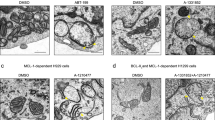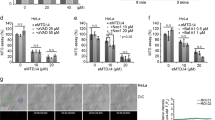Abstract
p53-upregulated modulator of apoptosis (PUMA) is a BH3-only Bcl-2 family protein and an essential mediator of DNA damage-induced apoptosis. PUMA is localized in the mitochondria and induces apoptosis through the mitochondrial pathway. However, the mechanisms of PUMA-induced apoptosis remain unclear. In this study, we found that second mitochondria-derived activator of caspase (SMAC)/Diablo, a mitochondrial apoptogenic protein, mediates the proapoptotic function of PUMA by regulating PUMA-induced mitochondrial events. SMAC is consistently released into the cytosol in colon cancer cells undergoing PUMA-induced apoptosis. In SMAC-deficient cells, execution of PUMA-induced apoptosis is abrogated, in company with decreases in caspase activation, cytosolic release of cytochrome c and collapse of mitochondrial membrane potential. Reconstituting SMAC expression restored these events in the SMAC-deficient cells. Furthermore, SMAC and agents that mimic the inhibitor of apoptosis proteins (IAPs) inhibition function of SMAC significantly sensitize cells to PUMA-induced apoptosis. These results demonstrate an important role of SMAC in executing DNA damage-induced and PUMA-mediated apoptosis and suggest that SMAC participates in a feedback amplification loop to promote cytochrome c release and other mitochondrial events in apoptosis.
This is a preview of subscription content, access via your institution
Access options
Subscribe to this journal
Receive 50 print issues and online access
$259.00 per year
only $5.18 per issue
Buy this article
- Purchase on Springer Link
- Instant access to full article PDF
Prices may be subject to local taxes which are calculated during checkout






Similar content being viewed by others
References
Arnt CR, Kaufmann SH . (2003). The saintly side of Smac/DIABLO: giving anticancer drug-induced apoptosis a boost. Cell Death Differ 10: 1118–1120.
Brummelkamp TR, Bernards R, Agami R . (2002). A system for stable expression of short interfering RNAs in mammalian cells. Science 296: 550–553.
Chen Q, Gong B, Almasan A . (2000). Distinct stages of cytochrome c release from mitochondria: evidence for a feedback amplification loop linking caspase activation to mitochondrial dysfunction in genotoxic stress induced apoptosis. Cell Death Differ 7: 227–233.
Cory S, Huang DC, Adams JM . (2003). The Bcl-2 family: roles in cell survival and oncogenesis. Oncogene 22: 8590–8607.
Danial NN, Korsmeyer SJ . (2004). Cell death. Critical control points. Cell 116: 205–219.
Deng Y, Lin Y, Wu X . (2002). TRAIL-induced apoptosis requires Bax-dependent mitochondrial release of Smac/DIABLO. Genes Dev 16: 33–45.
Du C, Fang M, Li Y, Li L, Wang X . (2000). Smac, a mitochondrial protein that promotes cytochrome c-dependent caspase activation by eliminating IAP inhibition. Cell 102: 33–42.
Elbashir SM, Harborth J, Weber K, Tuschl T . (2002). Analysis of gene function in somatic mammalian cells using small interfering RNAs. Methods 26: 199–213.
Fulda S, Wick W, Weller M, Debatin KM . (2002). Smac agonists sensitize for Apo2L/TRAIL- or anticancer drug-induced apoptosis and induce regression of malignant glioma in vivo. Nat Med 8: 808–815.
Giagkousiklidis S, Vogler M, Westhoff MA, Kasperczyk H, Debatin KM, Fulda S . (2005). Sensitization for gamma-irradiation-induced apoptosis by second mitochondria-derived activator of caspase. Cancer Res 65: 10502–10513.
Green DR, Reed JC . (1998). Mitochondria and apoptosis. Science 281: 1309–1312.
Han J, Flemington C, Houghton AB, Gu Z, Zambetti GP, Lutz RJ et al. (2001). Expression of bbc3, a pro-apoptotic BH3-only gene, is regulated by diverse cell death and survival signals. Proc Natl Acad Sci USA 98: 11318–11323.
Hansen TM, Smith DJ, Nagley P . (2006). Smac/DIABLO is not released from mitochondria during apoptotic signalling in cells deficient in cytochrome c. Cell Death Differ 13: 1181–1190.
Hao Z, Duncan GS, Chang CC, Elia A, Fang M, Wakeham A et al. (2005). Specific ablation of the apoptotic functions of cytochrome c reveals a differential requirement for cytochrome c and Apaf-1 in apoptosis. Cell 121: 579–591.
Hemann MT, Zilfou JT, Zhao Z, Burgess DJ, Hannon GJ, Lowe SW . (2004). Suppression of tumorigenesis by the p53 target PUMA. Proc Natl Acad Sci USA 101: 9333–9338.
Jeffers JR, Parganas E, Lee Y, Yang C, Wang J, Brennan J et al. (2003). Puma is an essential mediator of p53-dependent and -independent apoptotic pathways. Cancer Cell 4: 321–328.
Johnstone RW, Ruefli AA, Lowe SW . (2002). Apoptosis: a link between cancer genetics and chemotherapy. Cell 108: 153–164.
Kohli M, Yu J, Seaman C, Bardelli A, Kinzler KW, Vogelstein B et al. (2004). SMAC/Diablo-dependent apoptosis induced by nonsteroidal antiinflammatory drugs (NSAIDs) in colon cancer cells. Proc Natl Acad Sci USA 101: 16897–16902.
Lakhani SA, Masud A, Kuida K, Porter Jr GA, Booth CJ, Mehal WZ et al. (2006). Caspases 3 and 7: key mediators of mitochondrial events of apoptosis. Science 311: 847–851.
Lassus P, Opitz-Araya X, Lazebnik Y . (2002). Requirement for caspase-2 in stress-induced apoptosis before mitochondrial permeabilization. Science 297: 1352–1354.
Li L, Thomas RM, Suzuki H, De Brabander JK, Wang X, Harran PG . (2004). A small molecule Smac mimic potentiates TRAIL- and TNFalpha-mediated cell death. Science 305: 1471–1474.
Ming L, Wang P, Bank A, Yu J, Zhang L . (2006). PUMA dissociates Bax and BCL-XL to induce apoptosis in colon cancer cells. J Biol Chem 281: 16034–16042.
Munoz-Pinedo C, Guio-Carrion A, Goldstein JC, Fitzgerald P, Newmeyer DD, Green DR . (2006). Different mitochondrial intermembrane space proteins are released during apoptosis in a manner that is coordinately initiated but can vary in duration. Proc Natl Acad Sci USA 103: 11573–11578.
Nakano K, Vousden KH . (2001). PUMA, a novel proapoptotic gene, is induced by p53. Mol Cell 7: 683–694.
Okada H, Mak TW . (2004). Pathways of apoptotic and non-apoptotic death in tumour cells. Nat Rev Cancer 4: 592–603.
Okada H, Suh WK, Jin J, Woo M, Du C, Elia A et al. (2002). Generation and characterization of Smac/DIABLO-deficient mice. Mol Cell Biol 22: 3509–3517.
Perfettini JL, Roumier T, Castedo M, Larochette N, Boya P, Raynal B et al. (2004). NF-kappaB and p53 are the dominant apoptosis-inducing transcription factors elicited by the HIV-1 envelope. J Exp Med 199: 629–640.
Rashmi R, Kumar S, Karunagaran D . (2005). Human colon cancer cells lacking Bax resist curcumin-induced apoptosis and Bax requirement is dispensable with ectopic expression of Smac or downregulation of Bcl-XL. Carcinogenesis 26: 713–723.
Reimertz C, Kogel D, Rami A, Chittenden T, Prehn JH . (2003). Gene expression during ER stress-induced apoptosis in neurons: induction of the BH3-only protein Bbc3/PUMA and activation of the mitochondrial apoptosis pathway. J Cell Biol 162: 587–597.
Sun H, Nikolovska-Coleska Z, Yang CY, Xu L, Liu M, Tomita Y et al. (2004). Structure-based design of potent conformationally constrained Smac mimetics. J Am Chem Soc 126: 16686–16687.
Susin SA, Lorenzo HK, Zamzami N, Marzo I, Snow BE, Brothers GM et al. (1999). Molecular characterization of mitochondrial apoptosis-inducing factor. Nature 397: 441–446.
Verhagen AM, Ekert PG, Pakusch M, Silke J, Connolly LM, Reid GE et al. (2000). Identification of DIABLO, a mammalian protein that promotes apoptosis by binding to and antagonizing IAP proteins. Cell 102: 43–53.
Villunger A, Michalak EM, Coultas L, Mullauer F, Bock G, Ausserlechner MJ et al. (2003). p53- and drug-induced apoptotic responses mediated by BH3-only proteins Puma and Noxa. Science 302: 1036–1038.
Waldman T, Kinzler KW, Vogelstein B . (1995). p21 is necessary for the p53-mediated G(1) arrest in human cancer cells. Cancer Res 55: 5187–5190.
Wang X . (2001). The expanding role of mitochondria in apoptosis. Genes Dev 15: 2922–2933.
Yu J, Wang Z, Kinzler KW, Vogelstein B, Zhang L . (2003). PUMA mediates the apoptotic response to p53 in colorectal cancer cells. Proc Natl Acad Sci USA 100: 1931–1936.
Yu J, Zhang L . (2003). No PUMA, no death: implications for p53-dependent apoptosis. Cancer Cell 4: 248–249.
Yu J, Zhang L, Hwang PM, Kinzler KW, Vogelstein B . (2001). PUMA induces the rapid apoptosis of colorectal cancer cells. Mol Cell 7: 673–682.
Yu SW, Wang H, Poitras MF, Coombs C, Bowers WJ, Federoff HJ et al. (2002). Mediation of poly(ADP-ribose) polymerase-1-dependent cell death by apoptosis-inducing factor. Science 297: 259–263.
Zhang L, Yu J, Park BH, Kinzler KW, Vogelstein B . (2000). Role of BAX in the apoptotic response to anticancer agents. Science 290: 989–992.
Zhao J, Jin J, Zhang X, Shi M, Dai J, Wu M et al. (2006). Transfection of Smac sensitizes tumor cells to etoposide-induced apoptosis and eradicates established human hepatoma in vivo. Cancer Gene Ther 13: 420–427.
Zhou LL, Zhou LY, Luo KQ, Chang DC . (2005). Smac/DIABLO and cytochrome c are released from mitochondria through a similar mechanism during UV-induced apoptosis. Apoptosis 10: 289–299.
Acknowledgements
We thank Dr Xiaodong Wang and Dr Patrick G Harran at the University of Texas Southwestern Medical Center for providing the SMAC mimetic and control compounds, Dr Eileen White for providing the SMAC antibody, Dr Chunying Du at the Stowers Institute for Medical Research for providing the SMAC expression plasmid, Ms Hongtao Liu for technical assistance and members of our laboratories for helpful discussions. This work is supported by NIH Grant CA106348, grants from the Edward Mallinckrodt Jr Foundation and Elsa U Pardee foundation (LZ) and grants from the Flight Attendant Medical Research Institute (FAMRI), the Alliance for Cancer Gene Therapy (ACGT) and the Hillman Foundation (to JY). LZ is a scholar of the General Motors (GM) Cancer Research Foundation and the V Foundation for Cancer Research.
Author information
Authors and Affiliations
Corresponding author
Rights and permissions
About this article
Cite this article
Yu, J., Wang, P., Ming, L. et al. SMAC/Diablo mediates the proapoptotic function of PUMA by regulating PUMA-induced mitochondrial events. Oncogene 26, 4189–4198 (2007). https://doi.org/10.1038/sj.onc.1210196
Received:
Revised:
Accepted:
Published:
Issue Date:
DOI: https://doi.org/10.1038/sj.onc.1210196
Keywords
This article is cited by
-
LncRNA TP73‐AS1 promotes nasopharyngeal carcinoma progression through targeting miR-342-3p and M2 polarization via exosomes
Cancer Cell International (2022)
-
Inverse and reciprocal regulation of p53/p21 and Bmi-1 modulates vasculogenic differentiation of dental pulp stem cells
Cell Death & Disease (2021)
-
Role of apoptosis repressor with caspase recruitment domain (ARC) in cell death and cardiovascular disease
Apoptosis (2021)
-
Combined inhibition of XIAP and BCL2 drives maximal therapeutic efficacy in genetically diverse aggressive acute myeloid leukemia
Nature Cancer (2021)
-
PUMA-mediated epithelial cell apoptosis promotes Helicobacter pylori infection-mediated gastritis
Cell Death & Disease (2020)



